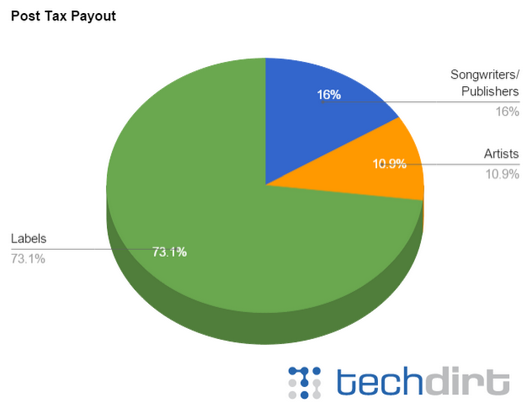 A pair of recent articles in the New York Times and Music Business Worldwide focus on the story of Perrin Lamb, a part-time singer-songwriter from Nashville. There is a narrative pushed by the music labels that artists can’t make money on streaming services. What seems closer to the truth is that music labels can’t make as much money as they would like from streaming services. Someone must pay for all of those music executive perks after all.
A pair of recent articles in the New York Times and Music Business Worldwide focus on the story of Perrin Lamb, a part-time singer-songwriter from Nashville. There is a narrative pushed by the music labels that artists can’t make money on streaming services. What seems closer to the truth is that music labels can’t make as much money as they would like from streaming services. Someone must pay for all of those music executive perks after all.
Along comes Mr. Lamb. He recently earned $44,100.60 from 10,929,203 streams from a single song on Spotify. His indie music distributor CD Baby took a 9% cut leaving him with $40,131.55. On the strength of this song, another one of his tracks racked up about 11 million plays and earned him another comparably sized check. His total earnings from these two songs exceed $80,000 since January 2014 and he can still continue to generate income as these and other songs are heard in the future.
These might not be earnings that would capture Taylor Swift’s attention, but she is a mega-star. Mr. Perrin was an unknown, unsigned artist before landing on a popular playlist on Spotify. He says in the Times article in response to a question about music labels, “No one ever offered me anything.” That may have been his lucky break. If he had signed with a label things might have been much different.
Who Receives Most Music Royalties: Music Labels
 Music labels claim righteousness in fighting for artists, but their rhetoric really supports good old fashioned self-interest. Analysis earlier this year of industry trade data by Techdirt revealed that 73% of royalties actually go to music labels. The scraps left over for recording artists amounted to just 11%. So if Mr. Lamb had signed with a typical music label his haul from 11 million plays on Spotify would have been closer to $4,800 which is very close to the distribution fees he paid to CD Baby. Maybe he would have made a few hundred more dollars from his rights as songwriter, but nothing close to his actual income. In a music label economic model the artist doesn’t do very well even when a song becomes a streaming hit.
Music labels claim righteousness in fighting for artists, but their rhetoric really supports good old fashioned self-interest. Analysis earlier this year of industry trade data by Techdirt revealed that 73% of royalties actually go to music labels. The scraps left over for recording artists amounted to just 11%. So if Mr. Lamb had signed with a typical music label his haul from 11 million plays on Spotify would have been closer to $4,800 which is very close to the distribution fees he paid to CD Baby. Maybe he would have made a few hundred more dollars from his rights as songwriter, but nothing close to his actual income. In a music label economic model the artist doesn’t do very well even when a song becomes a streaming hit.
The author of the Music Business Worldwide article Josh Collum has this to say: “Indie artists you discover on Spotify will get paid…If a writer or artist isn’t seeing the money, the answer to their question can probably be found within their label or publisher contract.”
Democratizing the Music Business
The other question to ponder is whether someone like Perrin Lamb could have ever had this success when the music label executives determined who gained exposure. It was a club. A few label executives and promoters enabled a handful of acts to gain audience exposure and kept everyone else out because access was limited. You had to pay “club dues” in terms of signing over royalty rights to get into the club. From there artists lost control over their creations and label executives extracted the vast majority of the value from the work.
 Streaming on YouTube, Spotify, Pandora, Slacker and other platforms has allowed artists ranging from Perrin Lamb to Macklemore to go around music labels and reach consumers directly. Mr. Collum’s article drives this point home about artists that go around the music label machinery and connect directly with fans through streaming services. He writes, “They’ve re-thought their businesses (yes, they are businesses) and the deals they choose to sign through the prism of a ‘Post-Napster’ perspective. And they are making a living that simply was not possible five years ago. These are the true success stories.”
Streaming on YouTube, Spotify, Pandora, Slacker and other platforms has allowed artists ranging from Perrin Lamb to Macklemore to go around music labels and reach consumers directly. Mr. Collum’s article drives this point home about artists that go around the music label machinery and connect directly with fans through streaming services. He writes, “They’ve re-thought their businesses (yes, they are businesses) and the deals they choose to sign through the prism of a ‘Post-Napster’ perspective. And they are making a living that simply was not possible five years ago. These are the true success stories.”
Maybe the biggest concern that music label executives have is losing their control of the industry and the money that comes from that position. Big houses and private jets cost money. If all of the artists start going directly to audiences through streaming and cut out the middle-man, the relevance and income of music labels will dry up.
Next week, we will have some analysis on the macro and micro economic realities of music streaming income. The conclusions run counter to claims offered by the music label executives. Perrin Lamb’s story also undermines the the music label narrative because it puts a face to a reality many would prefer not to acknowledge. His story illustrates the reality of a changing music industry where artists are exerting more control over their careers and benefiting. Artists always had talent. They didn’t have access to audiences without going through the music industry gate-keepers. Streaming music services now offer that access and allow artists to reach fans directly.
Now enjoy Perrin Lamb’s song that sparked all of this discussion.
Related Posts
Artists Should Blame Record Labels, Not Music Streaming
Apple Accepts the Worst Deal in Music Streaming – thanks to Taylor Swift
Taylor Swift vs. Spotify: What Advertisers Need to Know
